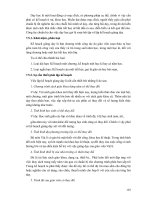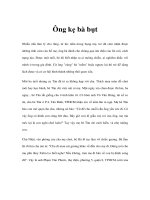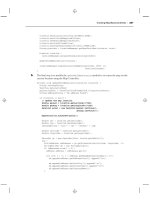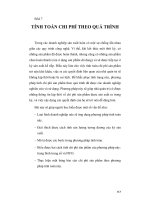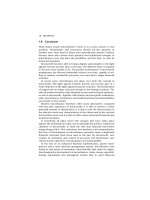Microfinance phần 7 ppsx
Bạn đang xem bản rút gọn của tài liệu. Xem và tải ngay bản đầy đủ của tài liệu tại đây (109.36 KB, 19 trang )
An accurate pricing policy, together with risk management measures,
could allow, in some cases, for less restrictive financial conditions
applied to beneficiaries, without compromising self-financial sustain-
ability. Risk management is a way to verify under which circumstances
sustainability does not come into conflict with outreach. In other
words, it is a way to verify under which circumstances microfinance can
be ethical and sustainable at the same time.
92 Microfinance
6
Monitoring the Microfinance
Processes
Monica Ortolani
6.1 Introduction
The distinguishing elements of microfinance compared with traditional
finance, as pointed out in the previous chapters, are the target clients and
the typology of the offered products. The satisfaction of the various needs
of the clients, located in different geographic locations, has led to the
development of many typologies of microfinance institutions character-
ized by more or less structured products – sometimes including non-
financial products – which also follow socio-ethical exigencies. Therefore,
the operational processes that are finalized to the achievement of the
strategic objectives – both economic and social – of the different institu-
tions have specific levels of standardization and complexity, and, conse-
quently, the arrangement of the performed activities changes. The ‘micro’
features of the offered products and the simplicity of the methodologies
used for their structuring and distribution is, indeed, the result of a num-
ber of activities that are carefully planned, organized and controlled. The
operational processes’ effectiveness and efficiency, despite the complexity
of the supplying institution, widely depends on the existence and on the
implementation of continuous monitoring and control systems for the
activities as well as for the human resources and tangible assets that
are used. Such systems must be correctly planned, implemented and
shared at all organization levels, in order to guarantee that all activities are
carried out correctly.
The aim of this chapter is to identify the typologies of control that
allow a correct monitoring of activities and of human resources used
during the production activities of microfinance, and also the monitoring
of the related information system. In order to achieve this, at first the
typical processes of microfinance are identified, focusing the attention
93
on microcredit, which is the most widespread process/product among
microfinance institutions. Afterwards, the risks concerning effectiveness
and efficiency are identified, focusing mainly on operational risks, since
financial risks have been already analysed in Chapter 5. Finally, the key
variables for a correct control and reporting system are chosen. This is to
achieve, at various levels, the correct monitoring of the activities and
the human resources to limit risks, while achieving the institutional
objectives efficiently and effectively, focusing on the structural elements
as well as on process elements. In such perspective, these issues will be
explained without making distinctions between formal and semi-formal
institutions, but keeping a process point of view. Such distinctions do
not influence the need to adopt a control system and an information
management system. Again, referring to the efficiency and the effective-
ness of the processes and to the risks related to human resources, the
incentive system is analysed; this is used very often as a functional
instrument for the achievement of the performance objectives, but
sometimes it can imply a relevant risk. In consideration of the above, we
will try to answer the following questions: why is the incentive system
so important in microfinance activities? Can the incentive system lead
to adverse selection behaviours and increase the risk of fraud?
6.2 Reasons for a process approach
Although microfinance institutions have their typical objectives, clients
and products, they operate according to the same effectiveness and
efficiency criteria as traditional financial institutions. In order to achieve
their objectives and to control the risks deriving from their operations,
MFIs need to adopt an internal control system that allows the monitoring
of the activities that are carried out and the related operating units.
Internal control system planning depends on the typologies of the
activities that are implemented and, therefore, on the number of prod-
ucts and services they offer and on the human resources that are used; for
each product/service there is generally a process that involves operating
units to which are assigned tasks and responsibilities. Therefore, in order
to define the best control system, it is necessary to identify the structural
and process components and the existing relationship between them,
especially in terms of information and reporting management system.
The control system is actually an instrument of active monitoring of
operations and management and, consequently, it is not only configured as
a control instrument, but also as a governance instrument. The internal control
system also systematizes the complexity of the institution by controlling
94 Microfinance
risks, by monitoring the trends of the most important variables, and by
creating an infrastructure that achieves an integrated management of all
processes and of human resources involved in a common scheme.
The definition of the institution’s structure consists in the identification
of the single operating units involved in the institution’s processes and
in the assignment of tasks and responsibilities that derive from the
organization of operations. The definition of the institution’s processes
concerns the organization of the necessary flow of activities and the iden-
tification of the related phases.
The link between organizational structure and processes is determined
when the tasks and the responsibilities related to the single activities are
assigned to the operating units. By doing so, it is easier to identify the
risks that derive from the above-mentioned components, and, therefore,
to plan the internal control system structure in order to be functional to
the specific typology of institution, to its objectives and to the control of
the specific risks. In light of the above, control activities apply to each
flow of activity and to each operating unit involved, following the prin-
ciple of tight relationship between structure and process components.
An effective and efficient internal control system is obviously supported
by an information and reporting system that allows the circulation of the
information deriving from the monitoring of activities and of operating
units. Information and monitoring reports must circulate from the top
to the bottom of the organizational structure and vice versa; in fact, by
doing so, the control system enhances its governance function, finalized
to optimize the management decision process in order to solve the prob-
lems promptly, before the achievement of the objectives is jeopardized.
The system needs to be simple, transparent and appropriately scheduled
in order to improve the actual operations of the institution at every
organizational level.
6.3 Microfinance processes
MFIs’ operations are characterized by the possibility of coexistence of
financial activities as well as socio-ethical ones; for each one of these
activities certain processes are structured up, in order to allow the pro-
duction of the service and its distribution to the beneficiaries. This section
only analyses the financial activities.
The processes of microfinance institutions are not different from those
used by traditional banking intermediaries and are grouped according to
the typical management areas in Governance processes, Production activity
processes, Support processes and Control processes (Figure 6.1). The set of
Monitoring the Microfinance Processes 95
Figure 6.1 MFIs’ processes
Source: adapted from Pesic (2005)
Governance processes
Strategic planning
Operational planning
Commercial policies
Risk management policies
Definition of organizational structure
Definition of the internal control system
Production activity processes
Credit management
Saving management
Collections and payments management
Trading on financial market management
Support processes
Infrastructure management
Information technology management
Human resources management
Budgeting and management control
Top management reporting
Disclosure requirements management
Control processes
I level controls
II level controls
III level controls
these four macro-categories of processes represents the map of the activ-
ities that are carried out inside the MFI; such macro-categories are
always present, yet the number of processes may vary depending on the
complexity of the specific institution, and is more structured for formal
MFIs compared to semiformal and informal ones. We mainly refer to
operations-related processes that depend on the products/services offered.
The identification of the above-mentioned processes also reveals the
responsibilities of the operating units inside the organizational structure
and, therefore, allows the identification of the control points, the tasks
and the roles of the single units within the internal control system itself.
The Governance processes area includes all those activities, organized in
processes, that are finalized to define the guidelines of the institution;
therefore, these activities represent the decisional process of the top
management. In particular, such processes define:
●
the strategic planning, with the institution’s medium- to long-term
objectives, the risk–return profile for each production activity, the
development plans, the target markets;
96 Microfinance
●
the operational planning, with the specific objectives for each business
unit, the risk–return objectives, the yearly budget, the investments
and the expenses;
●
the commercial policies, that is, the procedures through which the
agreed objectives are achieved;
●
the risk management policies which, depending on what has been
agreed during the strategic planning, outline the procedures and the
instruments used for the risk management, following the return
objectives (see Chapter 5);
●
the definition of the organizational structure, to adjust the structure of
the institution to the needs that derive from the chosen objectives
(i.e., the use of travelling loan officers in rural areas or suburbs);
●
the definition of the internal control system, depending on the
organizational structure and on the operational activities that are
carried out.
The Production activity processes depend, as previously mentioned, on
the quantity and typology of the services/products offered; to each
product corresponds a process; the products that characterize MFIs’
operations are credit management, saving management, collections and
payments management. With regards to the process concerning the trading
on financial markets management, we refer, in particular, to banks that
operate in the microfinance sector. The credit management process
surely represents the traditional and original process of microfinance, since
microcredit is the main product offered by these institutions (see
section 6.4). The saving management process identifies the typology of
saving products that meet the needs of the target clients; the demand for
these products is constantly increasing and has transformed many semi-
formal institutions into formal ones. The collections and payments
management process is aimed at meeting the needs regarding the transfer
of clients’ funds; in such context, the remittance issue is very important
for those MFIs that operate with immigrant clients.
The Support processes include all the activities that allow the institution
to carry out its work; they consist in cross-activities with the other
processes. The human resources management activities are particularly
important because they are a strategic element of microfinance; an
important matter in such context is the incentives issue, which is handled
in this process. The budgeting and management control process concerns
the planning of activities and the monitoring of the management
performance, using final period data and budget forecasting through
which the monitoring on the level of achievement of the objectives is
Monitoring the Microfinance Processes 97
performed. The top management reporting applies to the creation and
management of information reports regarding the operations and man-
agement of single areas. Such system should include at least three levels.
The first, regarding operations, should highlight the activities that are
carried out and their compliance with the operational planning of
reference; such activities are carried out by each single operational unit
(i.e., loan officers). The second level derives from the mergence of many
operative reports and it concerns the related management area (such
reports are written by the managers of each single area). The third level
synthesizes the flow of information of the other levels and provides the
achievement of the strategic objectives; it is forwarded to the bank’s
management and, depending on the information it contains, it allows
taking the appropriate decisions in order to improve the activities and to
perform the necessary corrections to achieve the objectives. For formal
institutions there are also disclosure requirements which are addressed
to the supervisors.
The Control processes concern the first, second and third level controls.
The typology of the controls will be deepened further on. For this
process we simply have to point out that also control activities are
organized in processes and the responsibilities have to be clearly defined
and assigned to specific bodies. Such processes provide information and
reports that support operational decision-making and the management
of the institution. The monitoring activity concerns both the activities
and the involved operating units.
Each process should be documented by a procedure, by a manual or
by operating instructions that details the specific responsibilities.
6.4 The process of microcredit
Microcredit constitutes, without doubt, the most distributed product of
all MFIs, whether they are formal, semi-formal or informal. The typology
of institution involved, as well as the participation in development coop-
eration programmes, influences the complexity and the organization of
the single activities, the product distribution and planning, but the
process as such remains the same. The distinctive element of microcredit,
regardless of the typology of supplying institution, is in the sought objec-
tive, that is, to satisfy the particular financial needs of the client through
the planning and distribution of a product that has the characteristics
suited to the satisfaction of this specific need (see Chapter 2), in an objec-
tive of effectiveness and efficiency, satisfying at the same time socio-
ethical objectives not present in traditional lending, first and foremost
98 Microfinance
the credit access to financially excluded individuals. Despite the exis-
tence of various typologies of MFIs, more or less formalized and struc-
tured, in its essence the microcredit process corresponds to traditional
credit process. The characteristics of the sought objectives require the
implementation of two further phases compared with the traditional
process, one at the beginning and one at the end (Figure 6.2), which
characterize the socio-ethical aims of microfinance and the ultimate
objective of the effective and lasting development of the beneficiary.
Some operational and management characteristics depend on the
supplying institution and on the type of programme being considered.
MFIs, which fund their activities mainly through deposits and are based
on balance principles between saving and lending activities, direct the
management and the operations towards aspects such as the quality of
the lending portfolio and the level of risk exposure. They also balance
risks and returns, by achieving through an adequate level of operating
efficiency.
On the other hand, MFIs operating with public grants and soft loans
prefer the outreach objectives rather than financial performance goals,
which represent compulsory restrictions. Below Figure 6.2 shows the dif-
ferences between the traditional credit process and the microcredit
process. The two processes differ in the initial and the final phases. The
other phases are identical even if they are characterized by differing oper-
ating methods and by the use of specific instruments. Such difference is
Monitoring the Microfinance Processes 99
Figure 6.2 Traditional credit process vs. microcredit process
Planning and
management
control
Granting
Recovery
management
Monitoring
Supporting
and training
activities
Granting
Monitoring
Exit
strategy
Resolution
Out
payment
Re-
evaluation
Evaluation
Traditional credit process Microcredit process
Planning and
management
control
Recovery
management
more evident in the sub-phases relative to credit granting, especially for
the evaluation.
Supporting and training activities: this phase is one of the features of
microcredit processes, which points out the focus on socio-ethical and
beneficiaries’ development objectives. Generally, especially regarding
microfinance included in development cooperation programmes, MFIs
are assisted by other partners that supply training services, social serv-
ices and other activities implying a specific knowledge of the territory
and the target beneficiary. Socio-ethical goals imply that the involved
MFIs take particular care of the phase preceding the microcredit supply;
in fact, the study of the local context, of its particular needs and of the
economical situation in which the institutions will operate, require pre-
liminary training activities. These activities are finalized to root a credit
culture among the future beneficiaries and local operators, in order to
favour the success of the programme; such particular activities are unfa-
miliar to the traditional credit. The traditional financial intermediaries
that take part in microcredit programmes generally entrust to MFIs all
the activities, as the one described above, that require a good territorial
knowledge.
Planning and management control: in this phase, which belongs to the
traditional credit process, all the activities related to the organization of
the credit production and distribution is performed. These activities
have to be coherent with the pursued objectives, with the development
policies and with risk–return goals agreed by the top management. Since
the microcredit programmes often use grants and soft loans, this phase,
compared with traditional credit, is affected not only by the objectives
and the operational requirements of the supplying institution, but also
by the strategies defined by the development policies of the large
national and international donors. Another distinction regards the dis-
tribution phase. The nature of microcredit, especially when offered to
populations living in rural areas, often requires the implementation of a
travelling distribution network that needs a careful planning and organ-
ization. Finally, during the planning and management control, the
accounting software system and the monitoring system are established.
Granting: this phase refers to the acquisition and the evaluation of the
credit requests. The approval/rejection resolution is provided by a special
body that, in microcredit programmes, is identified in the credit com-
mittee. The granting phase includes four sub-phases, as in traditional
credit process. The evaluation is the combination of the activities finalized
to verify the creditworthiness of the beneficiary. The qualitative and
quantitative features of the borrower are evaluated in both historical
100 Microfinance
and prospective terms, by the gathering of the client’s relevant informa-
tion. In microcredit programmes this activity is generally carried out by
loan officers by means of interviews and visits to the potential beneficiary.
The loan officers assist the future beneficiary in filling in the credit appli-
cation; then, the loan officers formulate a personal opinion which will
influence the credit committee in the credit resolution. Resolution, out-
payment and re-evaluation follow the same principles of traditional finance.
In development cooperation programmes, the credit out-payment can be
entrusted to a third party, most of the times a local partner.
Monitoring: this phase includes all the activities necessary to the con-
trol of the credit cash flow concerning the on-time repayments, and the
prompt management of default positions. Such management depends
on the ability to anticipate the occurrence of the default, by means of
adequate accounting and daily monitoring. It is, therefore, necessary to
have a reporting and management information system among all orga-
nizational levels. In microcredit, particular attention is dedicated to the
positions regarding solidarity groups, since the multiplier effect of any
possible default could represent a high risk. Hence, the information
regarding these ‘groups’ should be constantly updated. When the credit
is assisted by physical collateral – usually the property of the beneficiary
and his family (television, fridge, etc.) – the loan officer will have to
check on their condition during his visits.
Recovery management: this phase concerns certified default positions that
cannot be recovered. In this case, the local legislation of the target territory
plays an essential role: the chances of recovery are, in fact, tied to the pres-
ence and the intervention of external bodies, such as tribunal jurisdictions.
Exit strategy is the other distinctive phase of microcredit programmes,
in particular those included in development cooperation programmes.
It refers to the exit strategy at the end of the programme. In fact, in the
exit phase, the supplying institution must ensure that the funds dedicated
to microcredit have generated enough returns to guarantee the continu-
ity of the supported activities after the conclusion of the microcredit
programme and the exit of the MFI. In this phase, the socio-ethical
objective becomes significantly important. The microcredit must trigger
a virtuous mechanism and promote sustainable economical cycles over
time and not only during the programme. For this phase, for example,
the destination and the function of the residual rotation fund must be
programmed; the opening of a working ‘service point’ with specific
operating staff can be planned; alternative funding must be provided.
This new scenario represents the final objective of the programme in
terms of future sustainability.
Monitoring the Microfinance Processes 101
6.5 Process-related risks
Chapter 5 analyses the typologies of risk that can occur in the typical
activities of microfinance. In this section, the operational risks regarding
MFIs are analysed in greater detail. In order to do so, we will consider
operational risks without making a distinction between the different
typologies of institutions. In fact, the MFI’s complexity, its dimensions,
its particular equipment of human and material resources, can vary the
incidence of risks but not their occurrence.
The occurrence of operational risks regards the whole universe of
MFIs; the effects are inevitably negative for all institutions. As the risk
management concerns the complexity of the intermediary, either oper-
ational risks or financial risks must have an appropriate consideration in
the MFIs’ policies. The aim of an integrated management is to quantify
the overall risks in order to maximize the returns and the value of the
institution. Therefore, from a risk management point of view, it becomes
necessary for all MFIs to consider the operational risk management an
essential phase.
Operational risk is defined as the risk of loss resulting from inadequate
or failed internal processes, people and systems or from external events
(see Chapter 5). The occurrence of these risks depends on the circum-
stance that the processes related to the production activities (section 6.3)
have not been clearly defined and, as a consequence, are not managed
correctly by the responsible functions. This inevitably affects the
achievement of the objectives and, therefore, the satisfaction of the
client’s needs. Furthermore, in taking these risks MFIs could undergo
losses, fraud or abuses that have manifested themselves frequently in
the MFIs’ operations.
The risk management process comprises three main phases: iden-
tification, measurement and monitoring, quantification and manage-
ment of the risks linked to the single processes. This process of
identification, measuring and control must be implemented for each
MFI’s process; consequently, the internal control system must be
enabled on each one of those processes. In this sense the task of man-
agement is, first of all, to identify the key variables for the monitoring
of risks; the second step concerns fixing early warning or alert limits for
those risks thought to be strategic in relation to the monitored activi-
ties. Obviously this process will differ, according to the nature of the
institution and to the considered type of microcredit programme, in
relation to how important the risks are in order to achieve the MFIs’
objectives.
102 Microfinance
The risk management process is linked to the control process and is
incorporated into it. The trend regarding the financial intermediaries’
policies tends to consider the risk management process as a part of the
internal control system to enhance the institutional governance. Risk
management and control process have deep connections; the control
must be a part of the daily operations of the MFI in order to manage the
risks. At least one risk management function is suitable for more structured
MFIs, semi-formal and formal; this function must continuously guaran-
tee the identification, measurement and quantification of the risk. The
identification of processes and risks is essential for a good control system.
The operational risks that mainly affect MFIs are:
●
compliance risk;
●
interest conflict risk;
●
risk resulting from inadequate or failed internal processes;
●
risk resulting from people;
●
risk resulting from the fraud of the top or middle management;
●
risk of theft and internal fraud or unauthorized activities;
●
reputational risk;
●
risk of compensation, benefit and termination issue;
●
risk of losses arising from disruption of business or system failures;
●
risk of key performance indicators;
●
risk of losses arising from errors in the budgeting process;
●
risk of losses arising from errors in the strategic process.
The compliance risk consists in the possibility that the processes imple-
mented are not compliant to the procedures of the MFI; this risk can arise
from a mistaken definition of the process, from a poor functioning of
operating units or from human error. The interest conflict risk is repre-
sented by the possibility, in the operations, of a co-mingling of individual,
MFI’s and clients’ interests. The risk resulting from inadequate or failed inter-
nal process is represented by the possibility that the MFI’s internal processes
do not guarantee the achievement of the objectives for which they were
drawn up and/or require costs that are greater than budgeted and sus-
tainable costs. The risk resulting from people is the possibility that human
resources engaged in the management and/or control of a process do
not have the skills, experience or the professional requirements needed
to ensure the achievement of the expected objectives or to reduce the
main related risks to acceptable levels. Within the sphere of risks con-
cerning human resources, the risk resulting from the fraud of top or middle
management assumes particular relevance. It consists in the possibility
Monitoring the Microfinance Processes 103
that the management staff can change documents (i.e.; budgets, reports,
statements) with the intention of deceiving the recipients of the
information, for example, the donors. Moreover, the risk of theft and
internal fraud is the possibility that the employees, whether alone or in
collusion with third parties, perpetrate fraud, theft or carry out unau-
thorized activities against the MFI or the beneficiaries; it could happen,
for example, in terms of unauthorized utilization of financial and non-
financial assets. Loan officers’ frauds are the highest operational risk
for MFIs.
The reputational risk is the possibility that the MFI damages its rela-
tionship with clients, suppliers, donors and can lose professional employees,
harming its image in the marketplace. This risk is associated with the
stakeholders’ perception on the respectability and professional integrity
of the MFI and its employees, on the technical and professional skills of
all the resources in managing its business and on the quality and level of
the products and services offered. Within reputational risk, for MFIs
particular importance is assumed by the risk related to the customer satis-
faction that is linked to outreach goals and occurs when the processes are
not drawn up in such a way as to meet the expectations of the benefici-
aries; for example when the evaluation process is too articulated, or
when the MFI is unable to offer the client responsive product and serv-
ices. The risk related to communication is another kind of reputational risk
represented by the possibility that the communication system – vertical
(top-down and bottom-up) or horizontal – is ineffective. For example,
the employees are not fully aware of the mission, the objectives and the
strategies of the MFI; the management does not receive adequate infor-
mation on the organizational staff, especially local operating units and
loan officers, and, therefore, it cannot intervene to rectify any eventual
inefficiencies; the employees do not have the necessary support to fulfil
their obligations or to act in the presence of technical and operational
problems.
The risk of compensation, benefit and termination issue is represented by
the possibility that the employees do not agree with the performance
indicators used by the MFI. This may imply that the employees, in order
to reach the performance level and attain the incentive, are tempted to
act in a manner that does not conform to business objectives or to
strategies and ethical standards of the MFI. The incentive system is still
an unresolved problem for many MFIs and it is the major cause of fraud
and theft, especially by loan officers. The risk of losses arising from
disruption of business or system concerns the possibility that the used
information system may be inadequate for the operational processes
104 Microfinance
and does not satisfy the operating needs, compromising the reliability of
data and information. The risk of key performance indicators concerns the
possibility that the used indicators are inadequate for representing the
true financial and economical situation of the MFI. It can happen
when the performance indicators are not correctly balanced (for example,
between financial indicators and sustainability and outreach indicators);
or performance indicators do not consider the relationship between the
long-term returns and the objectives and strategies of the project.
Related to the financial management is the risk of losses arising from
errors in budgeting process, that is, the possibility that the defined objec-
tives are not attainable and not agreed upon. Finally, it is necessary to
mention the risk arising from errors in the strategic process. In this context,
the risk emerges when the MFI does not point out and analyse the infor-
mation concerning the target group, or when it disregards the regulatory
framework and the real possibilities of development that the environ-
ment actually offers.
6.6 Control typologies
In order to draw up an efficient internal control system it is necessary to
consider both the organizational structure and the process elements.
MFIs have different organizational structures depending on the institu-
tional typology; consequently the typology, the bodies and the processes
of control must suit the structural and organizational characteristics of
the concerned institution. In fact, the control components depend on the
activities and processes that are carried out, as well as on the objectives
pursued, and on the human and financial resources available.
Control activities are functional to the operations, to the related risks
and to the environment in which the MFI operates. The internal control
system aims to guarantee and monitor the effectiveness and efficiency of
the operational processes. This requires the reliability and integrity of the
accounting and management information, both for the MFI’s internal use –
such as operations and management needs – and for external requirements –
such as the compliance to local law and supervision regulation.
An effective control system requires dedicated human and financial
resources. The simple structure of some MFIs is combined with the need
to implement an effective system that defines the control activity and
attributes the relative responsibility to the appropriate bodies. Then, all
MFIs must implement an internal control system that respects the general
principles – functional to the system effectiveness – of separation between
management and control activities to avoid interest conflict risks. Once
Monitoring the Microfinance Processes 105
the MFIs’ processes, the responsible functions and the related risk
typologies have been identified, the internal control system is planned
and the methodologies to manage the identified risks are defined. In
this planning phase, the strategic objectives are taken into consideration
and, therefore, it is decided what level of risk protection is necessary and
which control typology must be implemented.
The control structure often does not correspond to the optimum
model, but simply to the most suitable one for the specific situation, for
the frame of reference and for the risk-return objectives that characterize
the MFI. The control system allows the management to handle all kinds of
risk, reducing their consequent negative impact as well as preventing them
from arising, in order to allow the achievement of risk and performance.
In this way, the internal control system is a governance instrument of
the institution, since it allows to promptly correct any malfunctions and
to achieve effectively and efficiently the MFI’s objectives.
The information management system, on the other hand, provides a
decision-making support to the various bodies of the organizational
structure, allowing the correct management of the processes. The need
to monitor and control the MFI’s operations implies the coordination
between control and executive bodies and the implementation of an
adequate reporting system to the top management. This system allows
to constantly monitor the level of risks and the staff members involved
in the operating functions. The control typologies on the activities and
on the human resources depend on the specific MFI; the control activity
requires the use of different control instruments (Table 6.1).
106 Microfinance
Table 6.1 Control typology – control instruments
Control typology Control instruments
Operational control
●
Manuals
●
Instructions
●
Procedures
●
Financial delegation of powers
Inspection control
●
On-site inspection reports
Management control
●
Strategic planning
●
Annual budgeting
●
Portfolio situation
●
Accounting and financial reporting
Quality control
●
Mission
●
Ethical code
Reporting control
●
Internal controls: check lists and reports
●
External controls: balance statement and
documents for disclosure requirements
Operational controls are carried out by operating units (for example by
loan officer) during their activities; included in this typology are the
controls deriving from the implementation of operating instructions
contained in the operating manuals (for example, the credit manual)
and in the operating procedures. Also included in this typology are the
automatic software controls; it happens, for example, in the evaluation
and in the granting of credit, when the staff member exceeds the agreed
limits.
Inspection controls on the operating units, both front and back office,
are aimed at verifying the compliance of operations with internal and
external regulations. Inspection controls are advisable even for the
simplest MFIs, in order to prevent the fraud risk, the compliance risk
and the risk resulting from inadequate or failed internal processes (see
section 6.5).
Management controls on accounting documents such as budgets, state-
ments, credit portfolios, etc., aim to verify the MFI’s situation in its
capital, economical and financial components.
Quality controls on socio-ethical activities are implemented to verify
the quality of the offered services.
Reporting controls refer to internal communication of the MFIs and to
disclosure requirements.
The control procedures must be described in appropriate documents
(procedures, manuals, operating instructions), containing clear and
defined rules on control activities and responsibilities. These documents
must contain the description of the instruments to be used and the infor-
mation flow that must be provided to manage all the risk typologies, in
order to guarantee continuously a correct operations and a flow of
reports on the obtained results and on the risks.
An MFI’s internal control system could be structured as are the ones
used by other financial intermediaries, according to the following three
levels:
●
First level These controls ensure that activities are compliant to pro-
cedures and manuals; they are carried out by the same operating
units (for example, hierarchical controls), or incorporated into the
software procedures, or performed by the back-office functions.
●
Second level These consist in risk management controls, which aim
to concur in the definition of the risk measurement system, to verify
that the limits assigned to the operative functions are respected and
to control the coherence of the operations of the single production
areas with the assigned risk–return objectives. These controls require
a specific risk management function.
Monitoring the Microfinance Processes 107
●
Third level These controls consist in the internal auditing process
and aim to identify anomalies, violations of procedures and internal
rules; they also evaluate that the overall internal control system
works correctly.
This monitoring activity can be carried out continuously, periodically or
exceptionally, also by means of on-site inspections. The control bodies
must be independent from the operating units.
6.7 The incentive system
The incentive systems used by MFIs can provide a positive contribution in
order to achieve the productivity goals. These are also indirect instruments
for the achievement of outreach and sustainability goals. On the other
hand, if used in an improper way, the incentive system represents a source
of operational risk for MFIs, and, as such, it has to be controlled.
MFIs’ experiences in using these systems suggest that, at present, there
is not an ideal model of incentive scheme. In some cases, the negative
side effects are higher than the benefits and the system has led to an
increase of the risk of theft and internal fraud or unauthorized activities.
Hence, it is necessary to perform a careful monitoring that focuses on
the human resources which, inside the MFI, can be interested in the
incentive system, and also analyses all the levels of the organizational
pyramid that can represent a source of risk.
Why is the incentive system so important in microfinance activities?
Because MFIs are characterized by high-intensity human labour activities
that imply higher responsibilities than the traditional banking system
does. In microfinance, incentives are used at all levels of the institutional
pyramid, including clients, staff members, management, up to the board
of directors (Table 6.2). The achieved results by the incentive system for
108 Microfinance
Table 6.2 Matrix incentives/beneficiaries
Tangible Tangible
Institutional Intangible non-monetary monetary
pyramid levels incentives incentives incentives
Board of directors XXX
Management XXX
Loan officer XXX
Clients XX
clients are mainly positive; in many successful microcredit projects,
many mechanisms have been used to induce on-time repayment by the
borrowers. For example, among the most used ones, there are graduation
principles through which the so-called excellent debtors are offered
larger loan amounts and longer loan terms; another interesting instru-
ment is the interest rebate, which consists in reducing the interest rate.
The aim of these instruments is to encourage the clients to adopt correct
behaviour with the MFI (a timely repayment activity allows the MFI to be
sustainable in the long term), but also to gain their loyalty.
At the second level of the institutional pyramid there is the operat-
ing staff. Staff expenses are undoubtedly the most important category
of costs, considering also the remote areas in which they operate. The
staff has a wider discretion compared with a bank’s personnel. The
compensation and the performance measurement systems assume a
strategic importance, with a great impact on MFIs. Incentives are rele-
vant in any activity, but the best application has been found with loan
officers and lending operations staff involved in microcredit projects.
This typology of operators plays a crucial role: they generate and safe-
guard the majority of the assets, determining most of the income of
microfinance organizations. Therefore, incentives have to be adapted
to performance. In the case of loan officers, the incentive system some-
times may result in contrast to sustainability and outreach goals. For
example, an incentive system that rewards the loan officer in proportion
to the number of stipulated contracts may compromise the programme’s
sustainability inducing the loan officer to stipulate microcredit
contracts also with beneficiaries without the necessary reliability
requirements.
Another important use of incentives is finalized to make the MFI’s
human resources loyal; the costs of searching, selecting and training
new resources would be, in most occasions, significantly higher than the
incentive itself. In such context, the incentive system can really help to
provide higher personnel stability which, because of the nature and the
location of the programmes, is obviously low.
The higher levels of the institutional pyramid are also included in the
incentive systems. If, on one hand, the board of directors aims to be
rewarded in terms of image, which is well in line with the pursued objec-
tives, on the other hand, the monetary incentives remain important.
Monetary incentives surely have a great impact on the rewarded
resources, but, at a second stage, other types of incentive, such as personal
ones, arise (Holtmann et al., 2002), (Table 6.3).
Monitoring the Microfinance Processes 109
6.8 Conclusion
Is it possible to define a standard internal control system that suits all
MFIs? The answer to this question is surely no. The main reasons are
essentially two. The first concerns the vast typology of microfinance
institutions; the second concerns the diversity of the specific objectives
of each considered project or programme.
The microcredit projects included in development cooperation
programmes, as well as other microfinance programmes, need effective
information systems that allow for controlling the execution of opera-
tional activities at all organization levels. However, for microcredit
programmes included in development cooperation programmes, the
socio-ethical elements and the typology of funding (usually donations)
imply that the process elements normally monitored by traditional finan-
cial intermediaries become relatively less important than the outreach
objective. Anyhow, also in these circumstances it is important that the
typical financial process contains the minimum elements of operational
and management control, as well as an adequate reporting, especially for
donors. In this perspective, MFIs and donors have to work in order to
improve the quality of the internal control systems adopted so far.
In the other microfinance projects the situation is different. MFIs,
without being traditional financial intermediaries, carry out activities
very similar to those performed by commercial banks, but include spe-
cific features that depend on the specific target typology and on the
offered product. For these MFIs it is necessary to have a structured inter-
nal control system that considers the specific risks and allows a constant
monitoring. Such system will be different for the specific MFI and will
depend on the typology of the supplied products, because the variables
that are considered strategic for control will change.
110 Microfinance
Table 6.3 Typologies of incentives
Intangible incentives
●
Sense of mission
●
Job satisfaction
●
Possibilities for promotion
Tangible non-monetary
●
Non-monetary benefits
incentives
Tangible monetary
●
Monetary bonus systems
incentives
●
Profit sharing
●
Stock ownership


